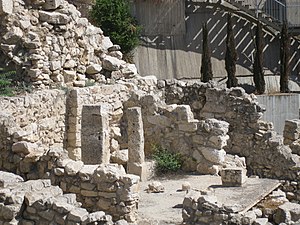 |
| Jerusalem model: The city of David, the Pool of Siloam and the southern wall of Mount Moriah. Israel Museum (Photo credit: Wikipedia) |
The paper's author, Jürg Hutzli, systematically goes over
the instances in which the expression ‘ir dawid appears throughout the books of
Samuel and Kings. His thesis argues that in most of the occurrences ‘city of David’
means 'citadel', 'fortress' or 'inner citadel'.
This is the minority opinion among biblical scholars. (In this paper, there is no
opinion about the meaning of ‘ir dawid from any archaeologist, in
case you were wondering.) The majority of commentators and dictionaries commonly translate ‘ir
dawid as ‘city of David’, that is Jerusalem, or at least, its southeastern hill. This is still the main opinion and probably so because the discrepancy in meaning seems restricted to the books of Samuel and Kings. Well, I did my own search of this expression and found that in the MT 'city of David' is found 18 times (five times in 2 Sam, six in 1 Kings and seven in 2 Kings). In the LXX though, the phrase shows up three more times (3 Kingdoms 2:35f; 10:22 and 12:24b).
| City of David עיר דוד (Photo credit: Wikipedia) |
The first two occurrences of 'ir dawid (2 Sam 5:7 and 9) should establish for us the meaning of the phrase, which is evident it refers to the 'stronghold' conquered by King David when he defeated the Jebushites. Throughout 2 Samuel the meaning of 'city of David' is consistent: it refers to what it seems a single fortified building.
As Hutzli kept analyzing several more examples I noticed, as he later points out, that the meaning of 'ir dawid becomes a bit more nuanced. For example, in 1 Kings 3:1 and 9:24, Hutzli admits of the possibility that 'ir dawid can be also translated as 'city' or 'quarter of town'. However, the context of the remaining passages where 'ir dawid is present in the Books of Kings does not provide us with a clear distinction that the 'city of David' refers to a section of the city with more than one building. Moreover, as his text study goes on, it is very interesting to observe that as the history of the kings of Judah progresses, 'ir dawid becomes steadily the place for the kings' interments (the formula occurs 13 times).
Hutzli finishes his article analyzing some examples where 'ir in the books of Samuel and Kings means 'tower' or 'fortification' (1 Sam 15:5; 2 Sam 2:3; 12:26-27; 2 Kings 25:27). This argument seems supported by the fact that in Old South Arabic the lexeme 'r means 'fortress'.
After reading this paper and looking at these texts carefully, I have become persuaded that those of us who study the Deuteroronomistic history should pay more attention at this minority scholarly position: 'ir dawid was probably a single, fortified, large building capable of serving as a shelter, a residence, a palace and a tomb.


0 comments:
Post a Comment